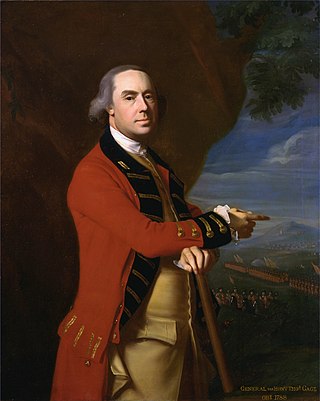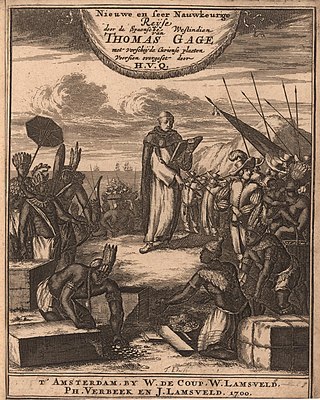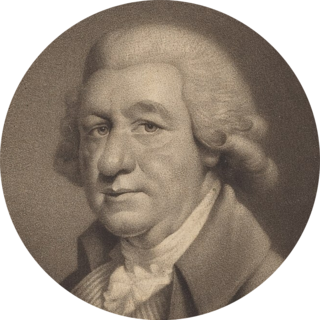
General Thomas Gage was a British Army general officer and colonial official best known for his many years of service in North America, including his role as British commander-in-chief in the early days of the American Revolution.

John Singleton Copley was an Anglo-American painter, active in both colonial America and England. He was probably born in Boston, Province of Massachusetts Bay, to Richard and Mary Singleton Copley, both Anglo-Irish. After becoming well-established as a portrait painter of the wealthy in colonial New England, he moved to London in 1774, never returning to America. In London, he met considerable success as a portraitist for the next two decades, and also painted a number of large history paintings, which were innovative in their readiness to depict modern subjects and modern dress. His later years were less successful, and he died heavily in debt. He was father of John Copley, 1st Baron Lyndhurst.

The Copley Medal is the most prestigious award of the Royal Society, conferred "for sustained, outstanding achievements in any field of science". It alternates between the physical sciences or mathematics and the biological sciences. Given annually, the medal is the oldest Royal Society medal awarded and the oldest surviving scientific award in the world, having first been given in 1731 to Stephen Gray, for "his new Electrical Experiments: – as an encouragement to him for the readiness he has always shown in obliging the Society with his discoveries and improvements in this part of Natural Knowledge". The medal is made of silver-gilt and awarded with a £25,000 prize.
The year 1889 in science and technology involved some significant events, listed below.

Viscount Gage, of Castle Island in the County of Kerry of the Kingdom of Ireland, is a title in the Peerage of Ireland. It was created in 1720 for Thomas Gage, along with the subsidiary title of Baron Gage, of Castlebar in the County of Mayo, also in the Peerage of Ireland. In 1744 he also succeeded his cousin as eighth Baronet, of Firle Place. The titles remain united. The Gage family descends from John Gage, who was created a baronet, of Firle Place in the County of Sussex, in the Baronetage of England on 26 March 1622. His great-grandson, the seventh Baronet, represented Seaford in Parliament. He was succeeded by his first cousin, Thomas Gage, 1st Viscount Gage, the eighth Baronet. He sat as a Member of Parliament for Minehead and Tewkesbury and also served as Governor of Barbados. In 1720, 24 years before succeeding in the baronetcy, he was raised to the Peerage of Ireland as Baron Gage and Viscount Gage. His second son was the military commander the Hon. Thomas Gage.

Joseph Warren, a Founding Father of the United States, was an American physician who was one of the most important figures in the Patriot movement in Boston during the early days of the American Revolution, eventually serving as President of the revolutionary Massachusetts Provincial Congress. Warren enlisted Paul Revere and William Dawes on April 18, 1775, to leave Boston and spread the alarm that the British garrison in Boston was setting out to raid the town of Concord and arrest rebel leaders John Hancock and Samuel Adams. Warren participated in the Battles of Lexington and Concord the following day, the opening engagements of the American Revolutionary War.
The Bye Plot of 1603 was a conspiracy, by Roman Catholic priests and Puritans aiming at tolerance for their respective denominations, to kidnap the new English King, James I of England. It is referred to as the "bye" plot, because at the time it was presented as a minor component of a larger plot.

Thomas Gage, 1st Viscount Gage of High Meadow, Gloucestershire and later Firle Place, Sussex, was a British landowner and politician who sat in the House of Commons as a Whig for 33 years between 1717 and 1754.

Sir Henry Gage was a Royalist officer in the English Civil War.

Thomas Gage was an English Dominican friar, best known for his travel writing on New Spain and Central America during a sojourn there of over a decade. He closely observes colonial society and culture. On his return to England in 1637 he converted to Anglicanism.

Margaret Kemble Gage (1734–1824) was the wife of General Thomas Gage, who led the British Army in Massachusetts in the American Revolutionary War. It is alleged that she played an important role in the outcome of the American Revolution. She was suspected of having divided loyalties and informing the American Revolutionaries of British troop movements.

Sir Brook Watson, 1st Baronet was a British merchant, soldier, and later Lord Mayor of London. He is perhaps best known as the subject of John Singleton Copley's painting Watson and the Shark, which depicts a shark attack on Watson as a boy that resulted in the loss of his right leg below the knee.

Firle Place is a Manor house in Firle, Sussex, United Kingdom. The Gage family have owned the land at Firle since acquiring it from the Levett family in the 15th century. The manor house was first built in the late 15th century by Sir John Gage, who made Firle Place his principal home. He held many high offices, including Constable of the Tower and was an executor of Henry VIII's will.

John Greenwood Sr. (1727–1792) was an early American portrait painter, engraver and auctioneer.
The 80th Regiment of Light-Armed Foot was the first light infantry regiment in the British Army.
Sir Thomas Copley (1534–1584) was a prominent English Roman Catholic politician and exile of the reign of Elizabeth I. Knighted, perhaps by the king of France, and created ennobled by Philip II of Spain, he was often known by contemporaries as "Lord Copley".

Fighting Odds is a 1917 American silent drama film produced and distributed by Goldwyn Pictures and starring stage beauty Maxine Elliott. The film is based on the play Under Sentence by Irvin S. Cobb and Roi Cooper Megrue. The picture was amongst Goldwyn's first productions as an independent producer. It was directed by veteran Allan Dwan and is a surviving film at the Museum of Modern Art, New York, and Gosfilmofond in Russia.

Katharine Greene Amory was an 18th-century Bostonian known for the journal she kept during the American Revolution. It is valued by historians for its record of daily life and for its window onto the viewpoint of a Loyalist woman.
Carrie Rebora Barratt is an American art historian specializing in museum administration and collaborative nonprofit leadership. She has worked in this domain in New York City since the 1980s. Barratt was Curator of American Paintings and Sculpture (1989–2009), and Manager of the Henry R. Luce Center for the Study of American Art (1989–2009) and Deputy Director for Collections (2009-2018) at the Metropolitan Museum of Art. She served as the Chief Executive Officer and William C. Steere Sr. President of The New York Botanical Garden 2018-2020 during a transitional period. Prior to that, she spent over thirty years at the Metropolitan Museum of Art as a curator and administrator.
Sir Berkeley Everard Foley Gage, KCMG was a British diplomat. He was British Ambassador to Thailand from 1954 to 1957 and British Ambassador to Peru from 1958 to 1963.














